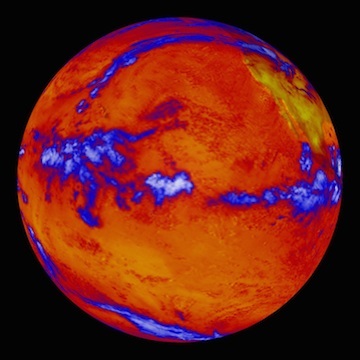370413-hot cold.jpg

Image shows heat radiating from the Pacific Ocean as imaged by the NASA’s Clouds and the Earth's Radiant Energy System instrument on the Terra satellite. Credit: NASA
A few years back, McDonald’s tried a change in the way it packaged its burgers. They were separated to keep the hot ingredients hot and the cold ingredients cold. And there seems to be a similar separation in the oceans. The warm upper layers seem to be getting warmer than thought, while the cold lower layers don’t seem to be getting any warmer at all.
About 90 percent of the extra heat created by global warming goes into the oceans. But tracking just where that heat is going is a tough job.
One team tackled the job by combining readings from satellites with other data to estimate temperatures in the deepest part of the oceans. Among other things, the satellites measure changes in sea level. Some of the change is caused by melting glaciers, which add water to the oceans. But some is caused by the water getting warmer, which causes it to expand.
Automated probes measure temperatures in the top mile or so of the ocean waters, which reveals how much of the rise in sea level comes from the expansion of water at those depths. Any extra rise in sea level would come from rising temperatures in the deepest part of the ocean.
That study showed little or no change from 2005 to 2013. In other words, the warmer temperatures weren’t really penetrating to the bottom of the ocean.
But a related study found that surface temperatures in the southern hemisphere have probably gone up much more than scientists had thought. So the cold side of the oceans is staying cold, while the hot side is getting hotter.

